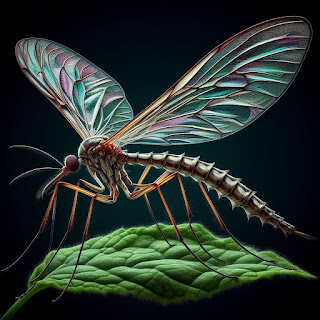Appearance and Anatomy
Mosquito hawks belong to the Tipulidae family, which includes thousands of species worldwide. Their most distinguishing feature is their long, slender legs, which resemble mosquitos and delicate craneflies. However, unlike mosquitos, mosquito hawks lack the piercing mouthparts required for blood eating. Instead, they have small, non-functional mouthparts that are mostly utilized for mating and rarely for food.
Mosquito hawks belong to the Tipulidae family, which includes thousands of species worldwide. Their most distinguishing feature is their long, slender legs, which resemble mosquitos and delicate craneflies. However, unlike mosquitos, mosquito hawks lack the piercing mouthparts required for blood eating. Instead, they have small, non-functional mouthparts that are mostly utilized for mating and rarely for food.
Habitat & Distribution
These friendly insects live in a range of habitats, including woodlands, meadows, and urban gardens. Some species flourish in tropical climes, although most are found in temperate zones. Their larvae, known as leatherjackets, reside in wet areas such as dirt and feed on decaying organic waste. This makes them significant contributors to nutrient cycling in ecosystems.
Ecological Role
Despite their deceptive moniker, mosquito hawks do not hunt mosquitos. Instead, they subsist mostly on nectar and other plant liquids, contributing to pollination. Adults have a brief lifespan, with most living only a few days to a couple of weeks. During this period, they concentrate on reproduction, with females laying eggs in damp soil or plants.
Dispelling Myths
One of the most persistent misconceptions about mosquito hawks is their alleged ability to manage mosquito populations. While they ingest certain small insects and may accidentally catch a mosquito or two, they are not excellent mosquito predators. Their dietary habits and anatomy just do not support this idea. As a result, using mosquito hawks to kill mosquitos is not an effective pest control approach.
Interactions with humans
Mosquito hawks are generally considered harmless to people. They do not bite or sting, and their presence in nature provides no danger. In fact, they can benefit gardeners by pollinating plants and providing food for birds and other predators. However, their larval stage can occasionally cause modest damage to plant roots, especially in agricultural contexts.
Conservation concerns
Mosquito hawks, like many other insect species, suffer dangers such as habitat loss, pollution, and climate change. Temperature and precipitation trends can alter their life cycles, impacting both adult populations and larval development. Furthermore, the extensive use of pesticides in agriculture can have an indirect impact on mosquito hawks by decreasing their food sources and disturbing ecosystems.
Conclusion
Mosquito hawks may not be the fearsome predators their name implies, but they are interesting creatures that deserve love and respect. Understanding their genuine nature and ecological value allows us to cultivate a greater appreciation for the intricate web of life in which they play an important role. As we work to maintain our planet's biodiversity, let us not ignore the modest mosquito hawk and its essential contributions to our environment.




.jpeg)

